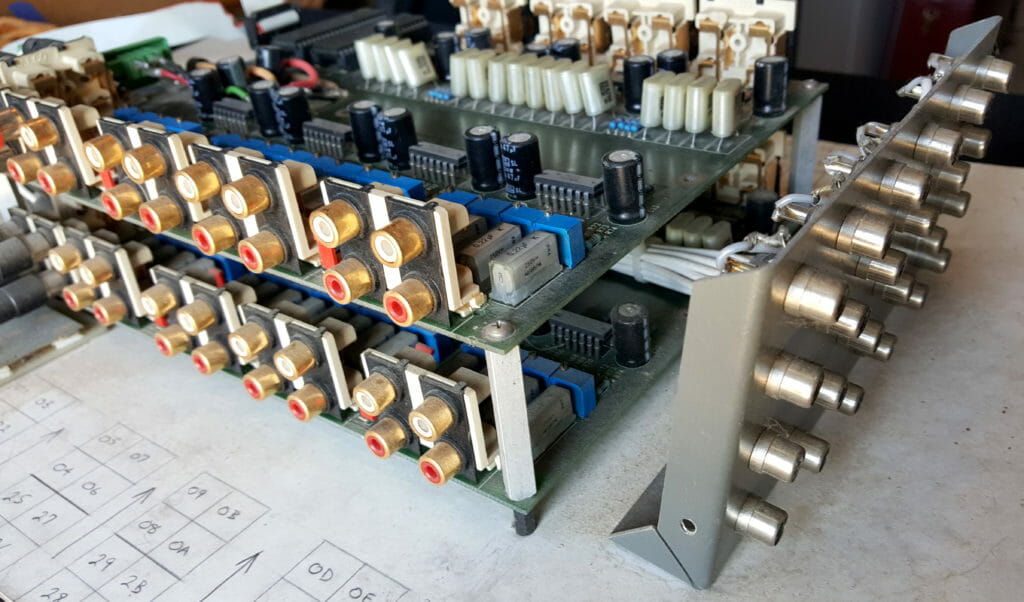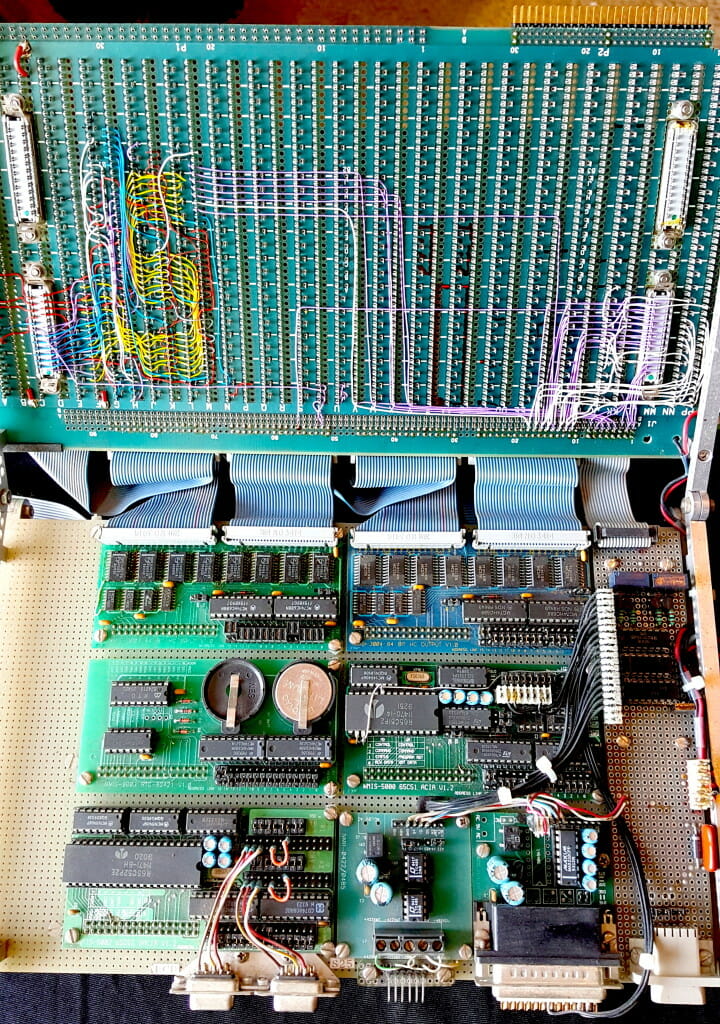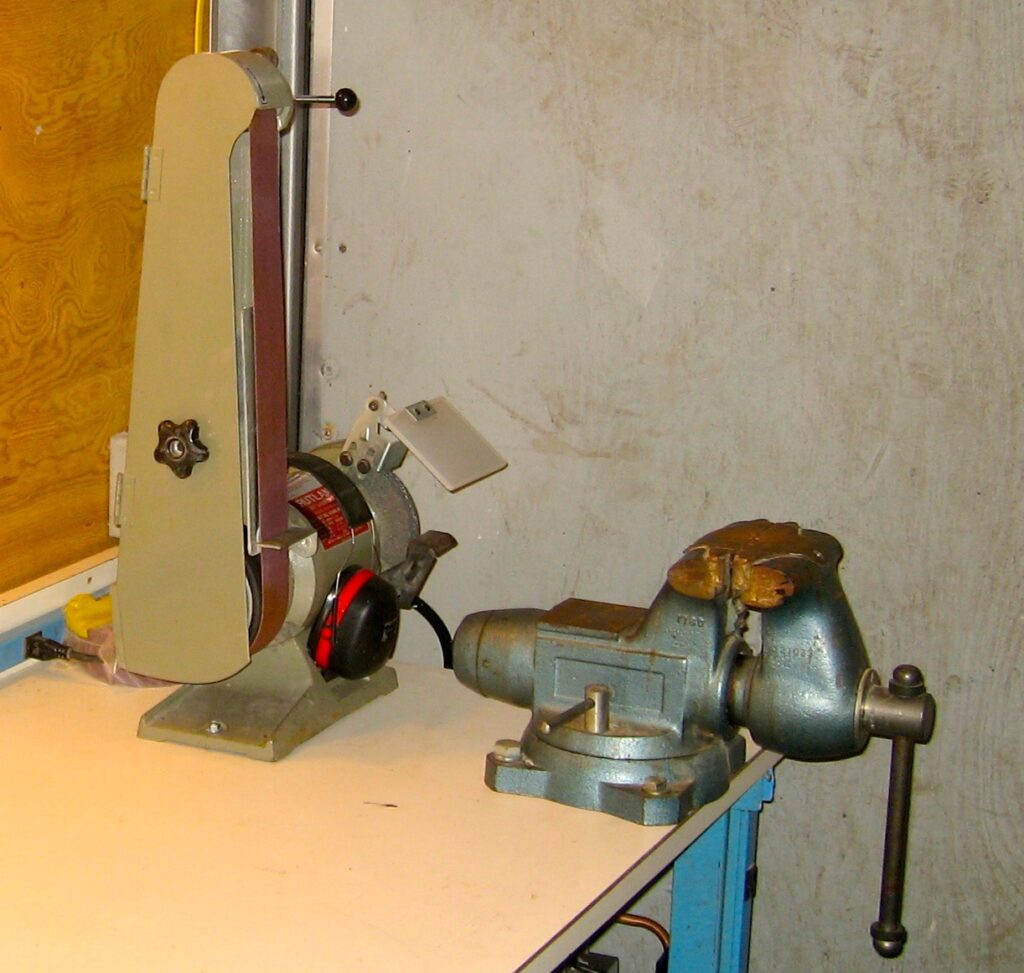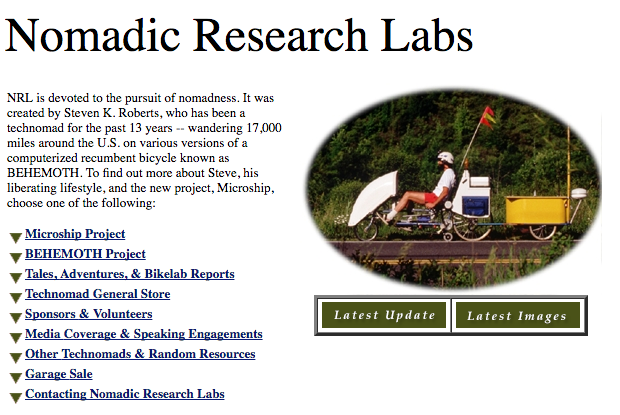
Microship Status 97 – Shipnet Online
by Steven K. Roberts
Nomadic Research Labs
Santa Clara, California
February 26, 1996
The Shipnet Is Back Online…
Since I’m poking my head up from three days of hacking to write this update, it’s fitting that I open with the status of the control network. It’s been a long time since my little suite of New Micros FORTH boards has sprawled across the bench, blinking happily, and it has been a growing priority to get the system back up and moving forward.
Accordingly, I rearranged furniture (always good motivation-therapy), and committed a two-tiered pair of tables to control system development — complete with a dedicated Mac. I moved everything to one power supply (which I couldn’t do back at UCSD, with a half-dozen student teams randomly power cycling nodes at all hours), removed a nasty little reflecting network stub linking the Audio and Video crossbar nodes that was causing the communication noise I was moaning about in Issue #93, and generally gave the whole system a tune-up. It also seemed a good time to add a task that displays the video turret status in the form of a blinking green LED (1 means it’s alive, 2 means the GBC camera is on, 3 means the Sharp color camera is on, and 4 means they’re both on), so I did that and then fixed it the next day (ahhh, software).
Then came a day of network tool-building. If you’ve been following this project since the Early Days, you know we’re using Microphone II on the Mac as a development environment, with scripts to load the hub files and node tools, download applications, transmit node-select commands, wipe the EEPROM, etc. But, noooo, that wasn’t enough. I wanted the ULTIMATE button… one click to cold-start the hub and all nodes, successively load all the comm software and tools, install and start all multitasking applications, and then, for the grand finale, display a report file that shows the success, failure, or nonexistence of each node. This seemingly trivial exercise ate up a whole afternoon, but it works…

Today’s FORTH adventure was a step toward data collection. I’ve been in contact with John Labovitz, one of our volunteers in Seattle, on the subject of transmitting the Microship’s data stream to a Web-browseable database. In order to have some interesting live data to work with, we of course need hardware and primitives at the FORTH end… so the most obvious easy first channel is the International Medcom RadAlert radiation monitor, which puts out a TTL-level pulse for each hit on the geiger tube. The tricky part was the lack of a manual for the Hub’s counter board, based on one of those universally flexible chips that require all sorts of status and control register interaction. Too impatient to wait for documentation, I muddled through the reverse-engineering, shorted the system clock a few times, confused myself mightily, and finally got it. The first variable in the Hub’s live data list, therefore, is RAD-CPM — the number of counts in the previous minute.
This was all so amusing that I took occasional time out to help Faun install our new decontamination station substrate, a project involving the visceral pleasures of plumbing, sawing, drilling, sealing, thumb-smashing, and the inevitable trips to Home Depot.
Moving on…
Astounding Help Responses!
Ahh, I do love the Internet! In issue #96, two weeks ago, I put out a call for help on the project. I had no idea what the response would be, but held my breath as I clicked SEND to launch the missive to about 2,000 people.
The response was amazing. Our volunteer database now stands at 54, about 75% of whom came from that one posting. We have some extremely well-qualified people offering to help, from networking and software wizards to hardware hackers, from machinists to composites gurus, from seasoned generalists to eager beginners. Equipment and resources ranging from vacuformers to new development systems have been added to our armamentarium of tools, and we’ve already seen some of the items in the Job Jar get claimed by folks across the land. Our first Development Team Meeting/Party is this coming Saturday, and there’s a feeling of movement afoot!
A few acknowledgements: Randy Devol (owner of the TriFoiler Blade Runner) came by a week or so ago and helped put the first of the antennas up — a little scanner antenna that we use for monitoring, TV, etc. (Coming soon: an HF vertical to go with the tuner kit that is finished and sitting on the bench.) Mark Moorcroft loaned us his robust Wilton vise (and installed it), helped Faun with imagemaps, and found the fuse-blowing problem with the Mothership’s horn circuit (a shorted horn). Sandy Nicol helped with database entry, Rosanna Embury is working on launching the Technomadic home base operation (much more on that in a couple of months…), and various technical project teams are slowly shaping up over the net. Sincere thanks to all!

Mast, Furler, And Rigging Updates
The biggest and most obvious critical-path item is to get the ship rigged and on the water for initial test sails. This also happens to be the area furthest from my experience, so I’ve been depending heavily on the advice of marine architecture consultants and other boat-folk. As I mentioned in an earlier report, John Marples spent a couple of days here, leaving us with a few rather daunting TO-DO items.
Well, progress is slowly happening. We extracted the original daggerboard and hacked a big section out of the trunk, and also ripped out the existing rudimentary furniture in the main cabin. Dave Berkstresser took some serious whacks at the old mast support arch, which, along with the battleship-grade mast step, is going to be junked and replaced with a bulkhead, bonded-in mast partner, and new lightweight step.
All along I’ve been planning to cobble together a rig based on the 42-foot used mast I got with the boat, but the rigging and spar contractors I’ve spoken with don’t seem too excited about using anything other than new gear… and I certainly don’t have the experience to do it myself. So we sold the mast this past weekend to some guys with a 35-footer in Santa Cruz, and got a quote in the $6,000 range from Ballenger Spars, covering the mast, boom, standing rigging, deck fixtures, and so on. I just sold the Fulmar-19 trimaran to a fellow in Texas who’s taking it to the Turks and Caicos Islands (near the Bahamas… sigh…), so we’ll just roll the cash over into rigging for the new ship. Less painful that way.
Speaking of rolling, our thanks go to Frank Sharp for the donation of his old Mariner roller-furler — a unique design that can be coiled up when the mast is lowered. Instead of a long extrusion, the unit rolls the sail around a wire headstay… an elegant solution for a trailerable boat!
News Bits
Faun has been spending 2 days a week at her new job — the West Marine store in Palo Alto. Her primary motives were education and employee discounts, and she’s already benefitting tremendously from the former. (The latter will come, believe me.) In the meantime, she’s also doing freelance web site design, plumbing, carpentry, accounting, desktop publishing, and even, now and then, something traditional like cooking dinner. She’s an amazing partner… the woman wields a wicked Sawzall, knows the Art of Spice, and fears not the Bin of CGI.
With the Fulmar on its way to Dallas this week, floor space opens up for the trailer project. We’re in the market for either a nice 6,000-pound capacity unit for cheap (yeah, right…), or a throwaway clunker which can have all its parts replaced except for the VIN (our current one never even HAD a VIN…). John Marples sent us a blueprint for an easy trailer design, so Faun may be doing a bit of arc welding soon <grin>.

Our Web Server is now current and actively updated once again! It’s being hosted by Zocalo, and is www.microship.com (you can even drop the www if your fingers are tired). Faun’s been adding files and rendering everything current, and upcoming projects include the data collection system, labcam array, more boat pictures, and Microship system documentation. We’re also expanding our set of pointers to other technomads and adventurers.
It looks like I’ll probably have the bike at the Nomadic ’96 conference in San Jose, March 13 and 14. Also, we’ll be hosting Steve Prior that whole week — he’s taking a vacation from his job at IBM back in the frozen northeast to help with Microship projects.
Yes, the fun never ends at Nomadic Research Labs… let us know if you want to join the party!


You must be logged in to post a comment.